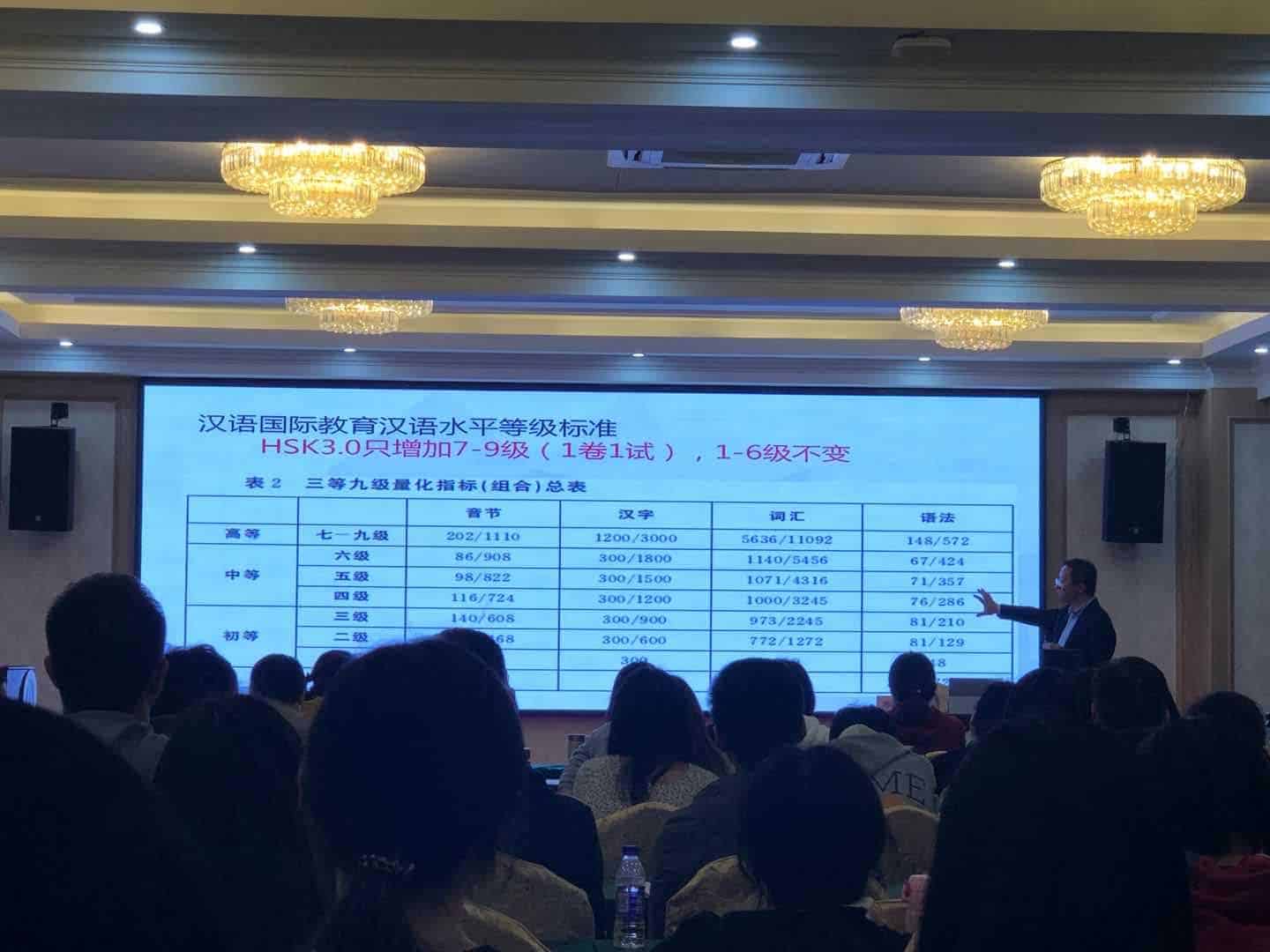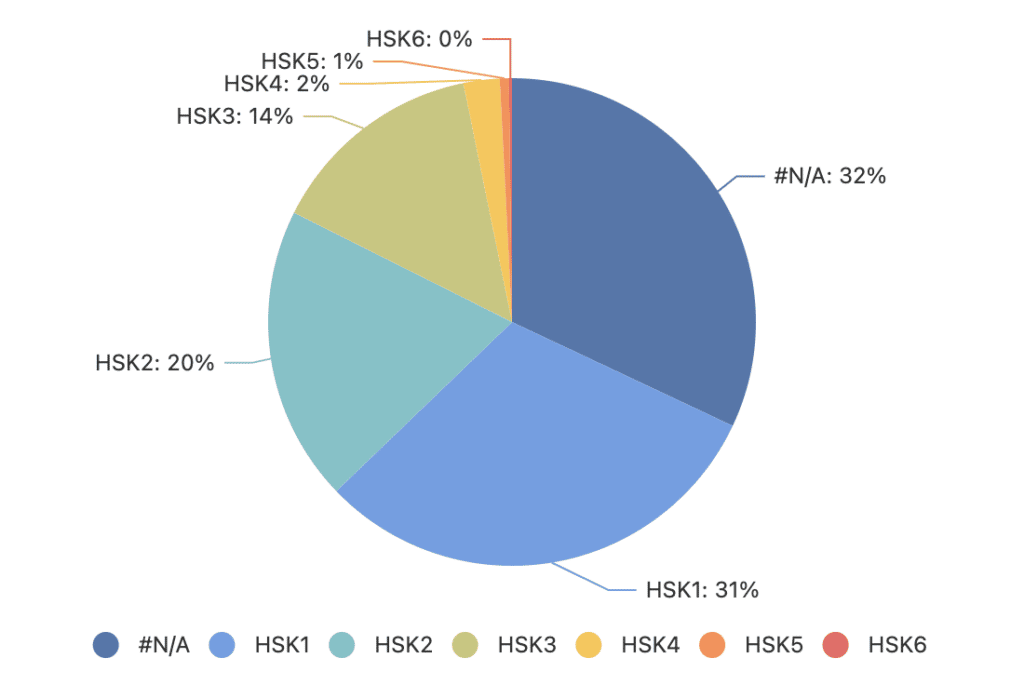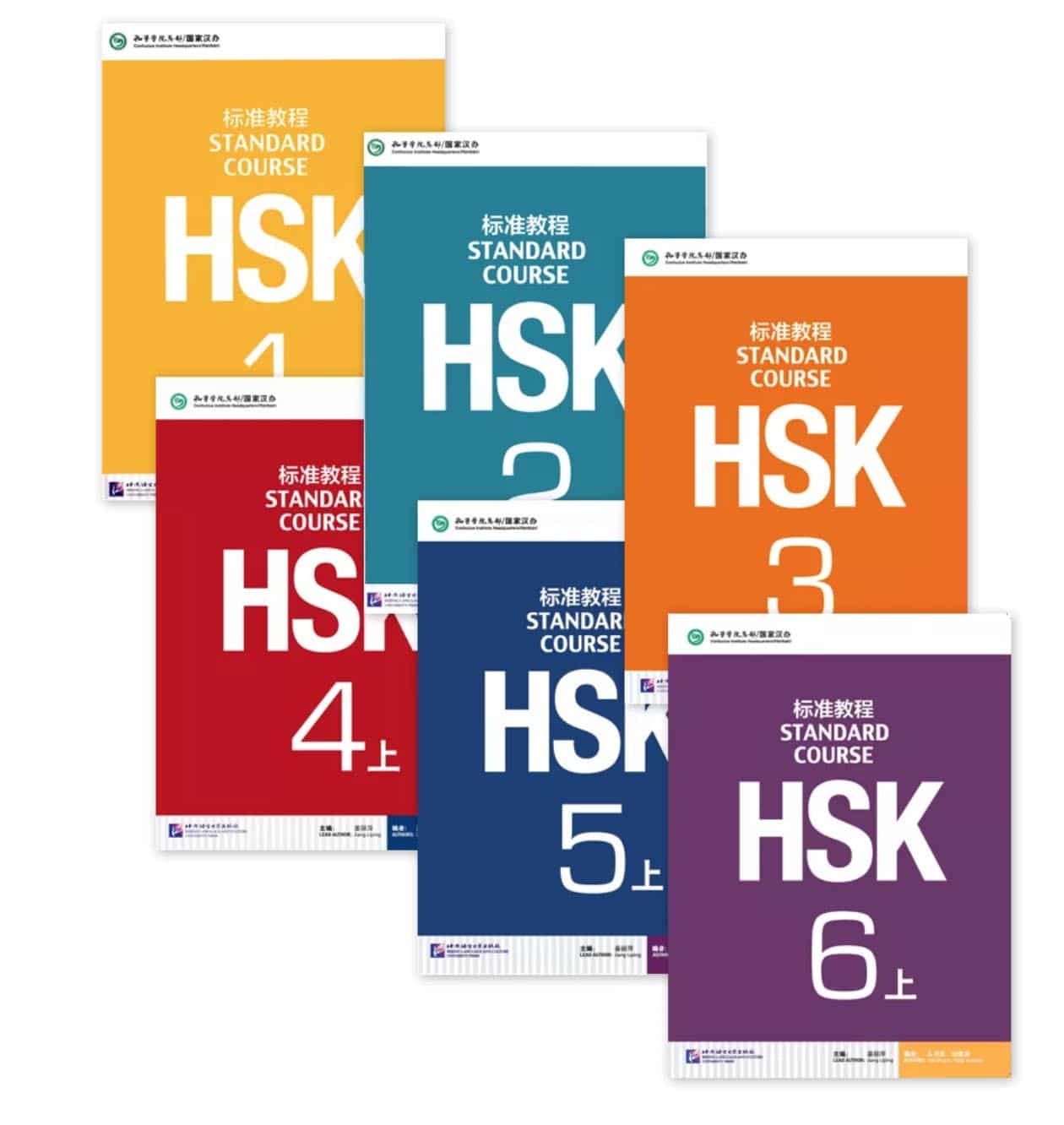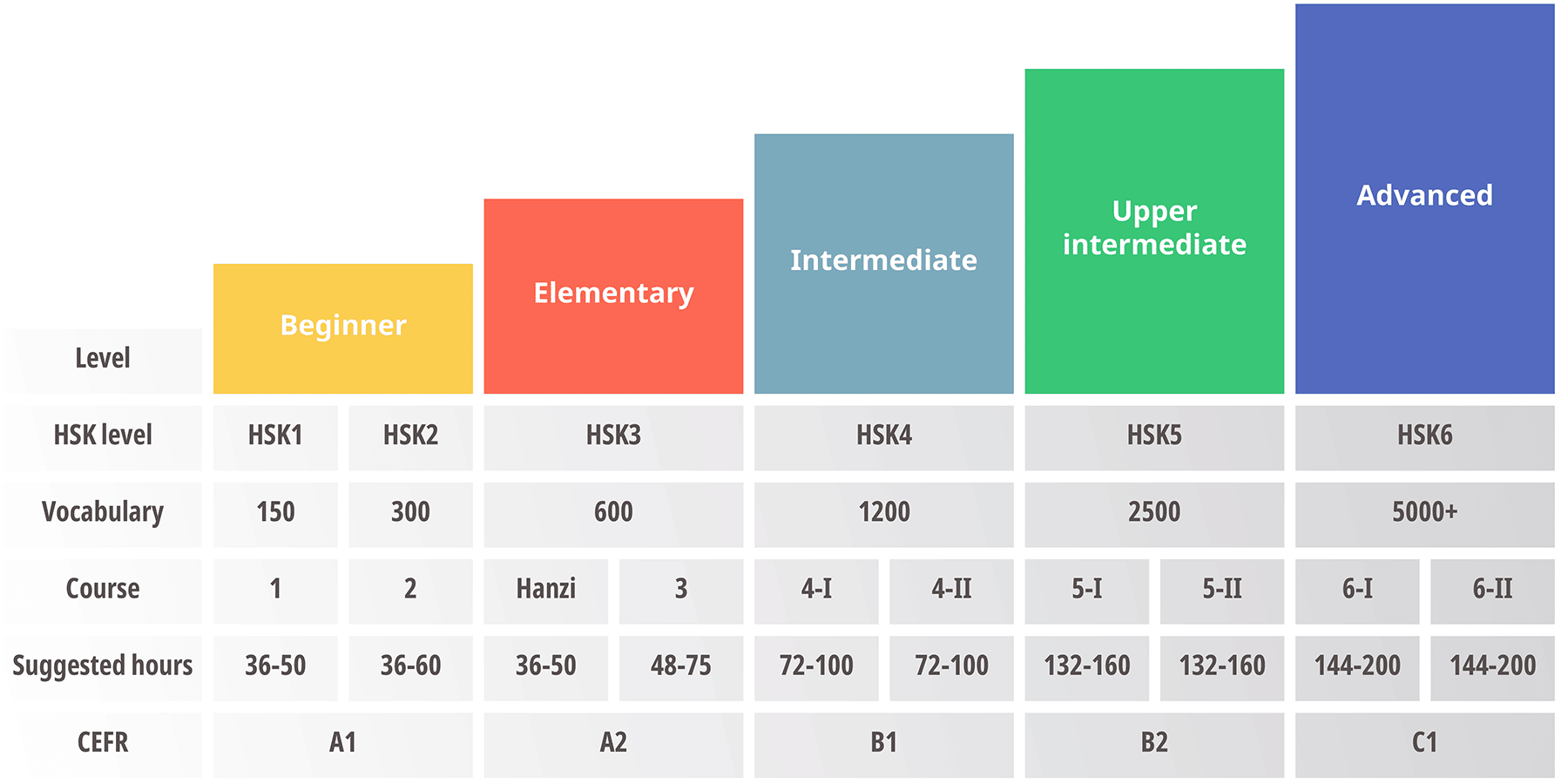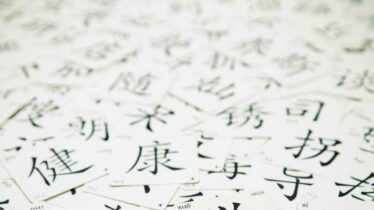New HSK levels for learning Chinese (Update 2025)
Master the New HSK with GoEast
Our expert teachers will guide you through the updated HSK format with personalized instruction and proven study methods.
Get the new HSK vocab list
See here the schedule for the 2025 HSK tests.
Biggest changes to the new HSK
1: Instead of 6 levels, HSK will have 3 levels and 9 bands (B1 to B9)
The old HSK is from HSK 1 to HSK6, while the new one is:
| Level | Band |
|---|---|
| 初等 (Elementary Level) | Band 1 |
| Band 2 | |
| Band 3 | |
| 中等 (Intermediate Level) | Band 4 |
| Band 5 | |
| Band 6 | |
| 高等 (Advanced Level) | Band 7 - 9 |
2: B1 to B5 aren’t corresponding to the original HSK1 to 5, they’re also much harder
| Old HSK level | Old vocabulary required | New vocabulary required | Difference from old HSK | New HSK |
|---|---|---|---|---|
| HSK 1 | 150 | 500 | +350 | Band 1 |
| HSK 2 | 150/300 | 772/1272 | +972 | Band 2 |
| HSK 3 | 300/600 | 973/2245 | +1645 | Band 3 |
| HSK 4 | 600/1200 | 1000/3245 | +2045 | Band 4 |
| HSK 5 | 1300/2500 | 1071/4316 | +1816 | Band 5 |
| HSK 6 | 2500/5000 | 1140/5456 | +456 | Band 6 |
| n/a | n/a | 5636/11092 | n/a | Band 7-9 |
The number before the slash means the new vocabulary within that level, the number after the slash means the accumulated vocabulary.
Based on our rough estimation, if you are currently an HSK4 level student, with the new standards, you will be regarded as “Elementary Level, Band 2”. If you are at HSK5, it will be “Elementary Level, Band 3”, while it seems HSK6 will still be Band 6.
So what has effectively been done is add two more levels between HSK5 and 6, which was indeed a huge step. Meanwhile, HSK1 to HSK3 will be regarded as Band 1/2.
3: A lot of completely new words are added to each new HSK level
The curriculum design team of GoEast quickly analyzed the 500 words required by the new Band 1 (B1), and we found out it is not just a mix of the old HSK1, HSK2, and HSK3 words, but around 100 vocabularies are the words never appeared on old HSK requirements.
We assume aside from new words, some words will also be dropped, because they’re no longer relevant (such as fax machine 传真Chuánzhēn).
4: Hanzi handwriting and translation skills are added, in addition to listening, reading, speaking, and writing skills
At Band 1, you will be required to be able to write 100 basic characters, and also the speed for copying the characters needs to be faster than 10 characters per minute. That’s right: copying, not from recall. At Band 2, it’s raised to 200 basic characters with a minimum speed of copying 15 characters per minute. And for Band 3, this becomes 300 basic characters at copying 20 characters per minute.
From Band 4, you will be required to have basic translation ability for both spoken and written Chinese. We’ll go into more details about this later.
How will the new HSK levels affect your Chinese learning?
1: The new requirements are actually closer to real life, and it helps you set up more realistic goals.
At first sight, it might be a bit frustrating that your level is way lower now. However, if you understand the current HSK exams were designed to lower the entry barrier to learning Chinese. The result is that some people (not GoEast students, alright!) who pass the HSK4 exam are still not able to hold a conversation in Chinese. At GoEast we also always say that the HSK6 level doesn’t correspond to C2 (advanced level), and we regard HSK3 as elementary, while a lot of other schools or self-study apps already name it ‘intermediate’.
But don’t let it dampen your motivation if you ‘drop’ a level: HSK levels are an academic reality, while your conversational level stays the same. The words you can speak are the words you can speak, to make the conversations you can make.
Meanwhile, understanding your ‘real level’ is helpful to success in learning Chinese. Plus the new structure will provide a better gauge on the level of someone’s Chinese language ability.
The biggest change is the three new bands: Band 7 to Band 9. These are meant to be a better gauge for students who major in Chinese language and literature or sinologists. The student will only need to take one exam for this range, and based on the score a certificate of HSK7, HSK8 or HSK9 will be given. Besides the original requirements of abilities of listening, reading and writing, the ability of translation will also be tested.
2: These standards will inspire better and more modern learning materials, which will make your learning experience more fun and efficient
Most of the currently authoritative textbooks were first written in the 90s or early 2000s and then revised after 2006. Of course, they were compiled and edited by great linguistics, but we have to say they are dated.
These new standards are destructive to old ones, which means just to ‘revise’ these old books isn’t going to work. We’ll be welcomed by a bunch of fresh, modern, and up-to-date materials. And GoEast will definitely be among those: we’re expecting lots of late nights and coffee for our curriculum designers in the half-year.
New HSK levels in detail
Here we’ll dive into the detailed requirements of each level and bands of the new standards of Chinese proficiency. There are not direct translations from the 260 pages of standards, but are the interpretations of GoEast Mandarin’s teachers, to help you understand everything easily.
Key takeaways
If you are at Band 3, you basically meet all the requirements that are very similar to a normal Chinese native speaker, which means your teachers or Chinese friends won’t have to speak to you in slower Chinese or try to pause — they can just talk to you naturally.
A big change to the old HSK exams is that handwriting is required from the very beginning. Most likely this is done because despite new devices, still need to write characters in real life in China, for example, when you fill in forms, like visas or university registrations, or when you just need to quickly leave a note to your colleague.
The details aren’t fully clear yet. It could be that on exams, you partly need to write some characters (corresponding to the level) from memory, while other characters you are allowed to copy yet within the given time limit.
Street signs and emails will also get special attention, which are very practical topics in real life!
New HSK Elementary Level (Band 1 to 3)
Overall requirements for learners:
- Understand simple Chinese texts
- Make daily conversations on limited topics
- Use simple communication strategies to help
- Have some knowledge of Chinese culture and cross-cultural communication skills
We can tell there are two major difference compared to old HSK 1 to 4/5:
- Chinese characters are required right away from the very beginning, while the old HSK1 and HSK2 only required Pinyin on exams
- Culture and cross-cultural communication are included
Let’s take a close look into HSK B1, HSK B2, HSK B3.
Language topics B1, B2, B3:
Band 1:
Personal information, daily routine, food, transportation, hobbies, etc.
Students should be able to complete related communication tasks such as: Know how to use polite words and phrases in different situations; Get information needed in a public environment.
Band 2:
Basic social life, family life, school life, shopping, dining, personal feelings, etc.
Students should be able to do tasks like smoothly order food in Chinese restaurants while having nice conversations with Chinese friends over the meal; fill in a personal information form.
Band 3:
Travelling, school/work description, entertainment activities, festivals, education, occupations, etc.
Example tasks are talking about your plan over the Chinese Spring Festival; send out a formal either written or oral invitation for an activity.
Listening B1, B2, B3:
Band 1:
Understand words, phrases and single sentences (with 80 words); Understand standard, clear and slow Chinese Mandarin, but the speed shall no slower than 100 characters per minute.
Understand some more complicated sentences with the help of pictures or real objects.
Band 2:
Understand simple dialogues of daily simple topics (within 150 words), and understand standard, clear and slow Chinese Mandarin, but the speed will be no slower than 140 characters per minute.
Also, students need to understand more complicated dialogues with the help of gestures or facial expressions.
Band 3:
Understand long sentences, short paragraphs, and simple speeches (within 300 words).
Students must be able to understand standard Putonghua or slightly accented, clear and normal speed Chinese Mandarin, which means the speed shall be around 180 characters per minute.
Understand more complicated situations via the changes of tones, speed and emotions in the speakers.
Speaking B1, B2, B3:
Band 1:
Pronounce 269 pinyin syllabus correctly (example: ài, hèn, rén, shì), and students must be able to ask simple and answer questions.
Band 2:
Pronounce 468 pinyin syllabus correctly (example:ān, chūn, liáng, yú ). Students must be able to hold short conversations or monologue, and be able to make appropriate small talks in different social situations.
Band 3:
Pronounce 608 pinyin syllabus correctly (example: chǎn, móu, quē, shuāng). Students must be comfortable in daily conversations, and be able to hold some discussions.
Reading B1, B2, B3:
Band 1:
Recognize 269 pinyin syllabus, 300 Chinese characters, and 500 vocabularies.
With the help of pictures or pinyin, be able to read simple texts (with 100 Chinese characters) at a speed of no less than 80 Chinese characters per minute.
Recognize basic popular symbols from street signs, notes, forms and maps.
Band 2:
Recognize 468 pinyin syllabus, 600 Chinese characters and 1272 vocabulary.
With the help of pictures, pinyin or dictionary, be able to read texts (with 200 Chinese characters) at a speed no less than 100 Chinese characters per minute.
Be able to get information from more formal materials like announcements and emails
Band 3:
Recognize 608 pinyin syllabus, 900 Chinese characters, and 2245 vocabulary.
Be able to read texts (with 300 Chinese characters) at a speed no less than 120 Chinese characters per minute.
Be able to get information from narrative or explanatory texts
Get the meaning of new words with a dictionary.
Have the reading skills of skimming and skipping reading
Writing B1, B2, B3:
Band 1:
Know how to handwrite from memory 100 basic characters. Example: 三(sān three), 鸡 (jī chicken). Students must understand the basic strokes, stroke orders and common punctuations.
Aside from writing from memory, students must be able to copy more complex characters at a speed of no slower than 10 characters per minute.
And students must be able to fill in personal information forms and leave a simple note to their friends.
Band 2:
Know how to handwrite 200 basic characters from memory. Example: 肉(ròu meat), 慢(màn slow). Students must be familiar with strokes, stroke orders, and common punctuations, and be able to copy characters correctly at a speed of no slower than 15 characters per minute.
Students must also be able to compose a paragraph of no less than 100 characters on familiar topics.
Band 3:
Know how to handwrite 300 basic characters from memory. Example: 喜(xǐ to like), 影(yǐng, shadow). Students should be comfortable with strokes, stroke orders, and all the punctuations, and must be able to copy characters correctly at a speed of no slower than 20 characters per minute.
Students must be able to compose emails, announcements or compositions of no less than 200 characters within the required time limit.
We’ll later look at the new intermediate levels, a level in which you are supposed to be able to work and study in China.
New HSK Intermediate Level (Band 4 to 6)
1: From a ‘controlled envioment’ to ‘real word’ conversations
elementary HSK levels, speaking or listening exercises are slower and clearer Mandarin with carefully selected words, limited topics, and short sentences. Yet the new intermediate HSK levels, everything is ‘real’, as in: people will speak at normal speed or even a very fast speed, they will make mistakes and correct themselves, some of them will have accents, sometimes the backgound is noisy, etcetera. This is all to test a student’s ability to really work or study in China, true to the name of ‘Hànyǔ Shuǐpíng Kǎoshì’ (HSK). Welcome to the real world, Chinese learners!
2: More topics, less personal
The second thing we notice about the new HSK levels and the content is that the topics are largely expanded from ‘talking about your personal information to things outside of your personal sphere; to communicate about general topics, about the society.
3: More context
Thirdly, students need to understand not just about understanding the language itself, but also understand context, culture, sacasm, humor, etcetera. This sounds vague but here’s an example: “你真是细心极了!” (Nǐ zhēnshi xìxīn jíle!)
Literary this means “you are really careful!”), but a lo of the time, becase of the strong emphasis, it probably means “you are too careless” in a real-life context.
4: Writing long articles
Writing in the upper new HSK levels isn’t just about characters or some sentences for information sake, it is about composing long articles well, apporiate for different situations even with some literacy skills.
Students are required to translate, as this is added in intermediate HSK levels. The test will involve mostly casual or informal occasions, such as you are translating for your colleagues on small talks.
6: A better grasp of whether a foreigner really speaks Chinese
cause of the above changes and requirements, it is safe to say that at this level, you are really able to study and work in China using Mandarin Chinese. In the past, a lot of companies required the old HSK5 for applying for a job; in the future, it probably will be ‘intermediate level’, which is more difficult to achieve.
Overall requirements for the new HSK B4, B5 & B6
- Understand Chinese texts with a variety of topics and themes
- Start & hold coversations in Chinese smoothly
- Able to discuss complicated topics in paragraphs, such as daily life, work, occupation, social and cultural related topics
- Know how to use common communication strategies to help
- Have good knowledge of Chinese culture and cross-cultural communication skills
Language topics B4, B5 & B6:
Band 4:
Topics include community life, health, school life, daily office communication, animals, plants, etcetera. An example of a task would be going to see a doctor with effective communication, or to be able to write a recruitment advertisement and answer candidates’ inquiries.
Band 5:
Topics include interpersonal relationships, lifestyle, learning methods, enviroment, society, etcetera.
Learners are expected to completed tasks like expressing their own thoughts on some social events, and to be able to give constructive suggestions and reply to work-related emails approriately.
Band 6:
Topics are going from more general life to specific work- and study-related fieds, such as business social interaction, coporate affairs, problem and conflict solving, and culture cmparisons.
Learners should be able to read Chinese news and make comments about it, and be able to hold discussions on Chinese history, culture, and other cultures in different situations.
Listening B4, B5 & B6:
Band 4:
- Understand casual or formal dialgues and texts of familiar topics easily (within 400 characters)
- Have no difficulty getting the meaning of natural Mandarin (180 to 200 characters per minute) even with accents
- Understand that there are redundancy or unnecessary pauses in someone’s speaking. Students should not be bothered by these and still get the main meaning
- Realize the culture-loaded meanings in conversations or speeches, for example, they must understand Chinese sarcasm or sense of humor
Band 5:
- Understand casual or formal dialgues and texts of family topics easily (within 500 characters)
- Have no difficulty in getting the meaning of natural Mandarin (200 to 220 characters per minute) even with accents
- Able to get full and detailed meanings when someone speaks with unnecessary pauses or keep repeating themselves or in a noisy environment
- Understand the culture-loaded meanings in conversations or speeches
Band 6:
- Understand casual or formal dialgues and texts of familiar topics easily (within 600 characters)
- Have no difficulty understanding the speaking from native speakers even at a fast speed (220 to 240 characters per minute) and with accents
- Able to avoid the influence of factors such as language disorders and corrections when in others speech, and understand the true intentions of the speaker
- Fully understand the culture-loaded meanings in conversations or speeches
Speaking B4, B5, B6:
Band 4:
- Pronounce 724 pinyin syllabus correctly and natually
- Able to do monolgues or speechs in paragrahs
- Able to narrate an event, describe a complicated situation, express opinions or feelings smoothly and accurately
Band 5:
- Pronounce 822 pinyin syllabus correctly and natrally
- Able to do monoloues or speechs in paragrahs with complicated sentences
- Able to describe events in details, express your full opinions in good logics with precise words
Band 6:
- Pronounce 908 pinyin syllabus correctly and natrally
- Able to do monoloues or speechs in paragrahs with complicated sentences correctly
- Able to describe events and situations in details, express your full opinions and feelings, hold dicussions and negotiations in great logics with precise, approriate, and smooth language
Reading B4, B5, B6:
Band 4:
- Recognize 724 pinyin syllabus, 1200 Chinese characters, and 3245 vocabularies
- Be able to read texts (within 500 Chinese characters) at a speed no slower than 140 Chinese characters per minute
- Be able to get main information from narrative, explanatory and argumentative texts
- Get the true meanings between lines
- Have good reading skills including skimming and skipping reading, guessing and associating.
Band 5:
- Recognize 822 pinyin syllabus, 1500 Chinese characters, and 4316 vocabularies
- Be able to read texts (within 700 Chinese characters) at a speed no slower than 160 Chinese characters per minute
- Be able to summarize main points from narrative, explanatory and argumentative texts, and make your own comments
- Can make your own logical reasoing and get the true meanings between lines
- Have good reading skills including skimming and skipping reading, guessing and associating, and infomation searching
Band 6:
- Recognize 908 pinyin syllabus, 1800 Chinese characters, and 5456 vocabularies
- Be able to read texts (within 900 Chinese characters) at a speed no slower than 180 Chinese characters per minute
- Be able to correctly summarize the structure, logic, and main points from any texts
- Fully understand the real contextual and cultural meanings between lines
- Have excellent reading skills including skimming and skipping reading, guessing and associating, infomation searching, and summarizing.
Writing B4, B5, B6:
Band 4:
- Know how to handwrite extra 100 intermediate level characters on top of the 300 basic characters. Example:( to ie), (
- familiar with compound characters’ structures
- Be able to correctly compose an article of narration or explanatory texts of no less than 300 characters within the required time limit
Band 5:
- Know how to handwrite extra 250 intermediate level characters on top of the 300 basic characters. Example:( to ),(g, ho)
- Be able to analyze the structures of different characters.
- Be able to correctly compose an article of narration, explanatory and simple argumentation texts of no less than 450 characters within the required time limit. Understand basic writing styles.
Band 6:
- Know how to handwrite extra 400 intermediate level characters on top of the 300 basic characters. Example: ( t), (dūn, )
- B able to comfortably analyze the structures of different characters.
- Be able to correctly compose a complicated article of narration, explanatory, and argumentation texts of no less than 600 characters within the required time limit. Understand a variety of writing styles and know how to use some common rhetoric like metphors
Translation B4, B5, B6:
Band 4:
- Have some basic translation ability (English to Chinese and vice versa)
- Be able to translate the main ideas and the cultural factors
- Be able to do basic interpreation during casual occasions
- Be able to translate written Chinese correctly
Band 5:
- Have some translation ability (English to Chinese and vice versa)
- Be able to translate the full ideas and deal with cultural factors approiately
- Be able to do basic consecutive interpretation during casual occasions
- Be able to translate written Chinese in a relatively accurate way
Band 6:
- Have general translation ability (English to Chinese and vice versa)
- Be able to translate the full ideas and handle cultural factors in a nice way
- Be able to do sooth interpretation during casual occasions
- Be able to translate different styles of written Chinese accurately
New HSK Advanced Level (Band 7 – 9)
These new bands are often called HSK7 to HSK9, but the official name would be 高等 (Advanced Level) Band 7 – 9. Key takeaways are:
1: Not everybody needs to reach these new HSK levels
New HSK’s Band 7 and 9 are most likely learning goals for students who are (or want to be):
- Planning to get a university or above degree in China in a program that is taught in Chinese
- Professional translators or Chinese language educators, sinologists
- In International Politics and Affairs
- In international trading
- Lawyers or policy/regulation analysts
2: All the learning materials are very professional and specific
…with a focus on academic research.
3: Learners aren’t just required to speak/write correctly, but also to do so elegantly
4: Learners are expected to fully understand Chinese culture and associated implicit meaning, to a level of cultural understanding that they think in Chinese language and similar to the way Chinese people think
5: Just one HSK exam
There’ll be only one HSK exam and your HSK level (Band 7 or 8 or 9) will be decided based on your score. We don’t know the vocabulary requirements for each separate band, but we only know for advanced level, learners are required to know 1110 pinyin syllabus, 3000 characters (know how to handwrite from memory 1200 characters), and 11092 vocabularies.
Overall requirements:
- Understand complex texts on a variety of subjects, in a variety of styles
- Hold in-depth discussions
- Conduct smooth communication on complex topics include social life, academic research, and other fields, with great logic, structure, and coherent text organization
- Have in-depth knowledge of Chinese culture
- Have an international perspective and great cross-cultural communication skills
Language topics B7, B8, B9:
Band 7:
Topics include social etiquette, science and technology, arts, physical education, psychology, and other professional fields.
Example tasks for students are exchanging ideas with participants on formal academic conferences, or to read course materials from specific majors.
Band 8:
Topics include linguistics, politics, economics, laws, philosophy, history, etcetera. Learners are required to be able to discuss political affairs, philosophy and religions in proper language. Learners should be able to express opinions, raise questions and appeals when encountering disputes.
Band 9:
Be prepared to encounter topics like academic research, policies, and regulations. These topics can apply to business and trading, or international affairs.
Learners are supposed to be able to formal business negotiations, and to be able to read formal documents of regulations and academic papers.
Listening B7, B8, B9:
Band 7:
- Understand lectures on general topics and social news (within 800 characters) at a normal or even fast speed
- Get the main facts and key opinions accurately and not be disturbed by any environmental factors
- Able to basically understand the social and cultural connotations involved
Band 8:
- Understand lectures on professional topics and specific social news (within 800 characters) at a normal or even fast speed
- Get the main facts, key opinions, and details accurately and not be disturbed by any environmental factors
- Able to understand and deal with the social and cultural connotations involved
Band 9:
- Understand any texts at a normal or even fast speed
- Able to analyze and get information when it is not fully presented
- Able to understand and deal with the social and cultural connotations involved well
Speaking B7, B8, B9:
Band 7:
- Express opinions, hold conversations or debates well with a variety of sentences and paragraphs
- Speak with standard and natural pronunciation
- Speak in different styles based on the situations
- Enhance the oral expressions with rhetorical methods such as metaphors
- Have the basic sense of cross-cultural communication
Band 8:
- Be able to do speeches and simultaneous debates well with a variety of sentences and paragraphs
- Standard and natural pronunciations, smooth language flows
- Enhance the oral expressions with a variety of rhetorical methods
- Have a good sense of cross-cultural communication
Band 9:
- Have excellent ability to speak on different topics in paragraphs/speeches
- Standard and natural pronunciations, smooth language flow
- Enhance oral expressions with a variety of rhetorical methods properly
- Have an excellent sense of cross-cultural communication
Reading B7, B8, B9:
Band 7:
- Read complicated texts on selected topics at a speed no slower than 200 characters per minute
- Have some understanding of Chinese ways of thinking and expression habits
- Understand the culture involved
- Have great reading skills including information searching
Band 8:
- Read complicated texts on related topics at a speed no slower than 220 characters per minute
- Have a good understanding of Chinese ways of thinking and expression habits
- Understand the cultural and social backgrounds involved
- Have great reading skills including information searching
- Able to spot language problems and logical flaws in the texts
Band 9:
- Read complicated texts on related topics at a speed no slower than 240 characters per minute
- Have a great understanding of Chinese ways of thinking and expression habits
- Fully understand the cultural and social backgrounds involved
Writing B7, B8, B9:
Band 7:
- Be able to handwrite 500 advanced characters
- Able to write argumentative, explanatory, and general essays, as well as professional papers of a certain length
- With basically clear points of view and structures, correct sentences and format, good and logical expressions
- Apply multiply rhetoric methods correctly
Band 8:
- Be able to handwrite 500 advanced characters.
- Able to write argumentative, explanatory, and general essays, as well as professional papers of a great length
- With clear points of view and structures, correct sentences and format, good and logical expressions
- Apply multiply rhetoric methods and idioms correctly
Band 9:
- Be able to handwrite 500 advanced characters
- Able to write a graduate thesis
- Write with clear points of view and structures, correct sentences and format, great and logical expressions
- Apply multiply rhetoric methods correctly
Translation B7, B8, B9:
Band 7:
- Have basic professional translation skills
- Able to conduct consecutive and accompanying interpretations on formal occasions
- Able to translate general, argumentative, and explanatory essays correctly
Band 8:
- Have professional translation skills
- Able to conduct consecutive and accompanying interpretations on formal occasions smoothly
- Able to translate general, argumentative, and explanatory essays of great length correctly
Band 9:
- Have good professional translation skills
- Able to conduct simultaneous interpretations on formal occasions smoothly and quickly
- Able to translate a variety of articles correctly and elegantly
Your questions about the new HSK answered
When do the new changes go into effect?
July 1st, 2021, but what does into effect isn’t 100% clear. This most likely means textbooks and learning materials published after this date will follow the new standards. But it doesn’t mean the current HSK exams will change after July 1st, 2021.
So when do the HSK exams change?
The news from the official test centers on April 20, 2021, is that in the next 3 to 5 years, the current HSK1 to 6 exams will remain unchanged. And then the reform will be carried out gradually.
By December 2021, the new HSK 7-9 exam will have mock tests published for feedback. and they’ll officially be launched from March 2022. So it is not possible to do the exam of HSK7~9 before March 2022.
Will my old HSK exams/certificates be valid?
Yes, all your certificates will remain valid, but they won’t be translated to the new grade boundary system.
Why are the HSK systems changing?
First, it’s good to know that HSK is just a system to grade Chinese; it doesn’t change anything to the Chinese language itself.
The old HSK system has provided a great structure to start learning Chinese, with students being able to go from HSK1 to HSK3 very quickly. But some critique on this would be that it’s too gentle and has been giving Chinese learners some false confidence of being ready to live & work in China using Mandarin Chinese, while in reality, those Chinese learners weren’t ready for it yet.
The previous highest level of Chinese, HSK6, does for instance not fully equal to C2 proficiency in English. One practical example is that students who just finished HSK6 still have problems reading Chinese novels.
This is what the new exams are aiming to change. Three more levels are added, and the distance from the old HSK5 to HSK6 is spaced out more. The new HSK levels will provide a better gauge on a student’s Chinese ability, and a higher ceiling — more similar to the requirements of native Chinese university graduates.
Do I need to buy new books?
There is no need for now. Right now, there are no books for the new HSK levels. The learning materials for these new standards have yet to be developed.
How do I prepare for the new tests then?
The new exams for HSK1-6 won’t be out for at least 3 more years. For nearly every situation, we recommend you simply keep learning the existing HSK courses. These will still prepare you for the new HSK courses. Words learned are words learned, regardless of academic testing.
When do the new books arrive?
This is just pure guessing, but we expect the books for advanced level from Beijing Language and Culture University Press will arrive first, at the end of 2021, or the beginning of 2022. (They also published the current yellow-turquoise-orange-red-blue-purple HSK books which are the bread & butter for many Chinese learners.
What about new GoEast HSK courses?
The GoEast Mandarin Academy team has also started to prepare the new HSK courses. We’ll build these new courses mostly from scratch, with a new chapter structure to prepare students for this new language grading. This means recording new videos, audio, flashcards, articles and preparing live lessons to fit the online learning materials.
GoEast academy will start developing the new courses later this year. These should be ready at the end of this year, so we can start using them to teach the advanced level (Band 7-9).
From 2022 on, GoEast will gradually start developing the new beginner and elementary levels (Band 1 – 6), which will probably take us, which will probably take us around a full year to complete. So we will be ahead of the new HSK band 1 to 6 exams being rolled out by one or several years.
At the same time, it’s worth noting that we have always used the HSK exams as a framework — but not a total blueprint, for our courses. We’ve always added words useful for daily life, to close the gap between classroom and reality. The new HSK framework also moves in this direction, so we feel like we have a headstart on other curriculum design institutions.
Right now we’ve finished the elementary vocabulary list which is freely available. If you wish to receive this, fill in the form on the top.
The handwriting on the exam requires writing from memory or copying from a paper?
We do not know the format yet. Will have a better idea by the end of this year.
Now HSK5 seems the minimum to attend a university in China or work in China, will this change?
Probably. We think Intermediate level B6 will become the minimum to really work and study in China (in Chinese). This is more comparable to the old HSK6 (with 500 more vocabularies) than it is with HSK5.
So this is ‘bad news’ if you hoped to get in easily, yet ‘good news’ because it pushes you to reach a level where you really understand more of the language used in your working or study environment.
Translating is new on the exams: is it translating from or to Chinese and from which language?
The translation will be required both from and to Chinese. Most likely will start from English.
How do I handwriting on an online test?
We do not know the format yet. Will have a better idea by the end of this year.
Why do I even need to do handwriting? Argh!!
The reasoning of the new HSK system is that when you live & work or study in China — despite phones & laptops — you still need to fill in forms and papers, and so this is why they require you to be able to do handwriting. We are still checking if it’s ALL from memory or simply copying, but probably it’ll be a combination.
Also, also Chinese children in primary school are learning to handwrite and to do so beautifully with the proper stroke order. It’s not like foreigners are treated unfairly here 😉
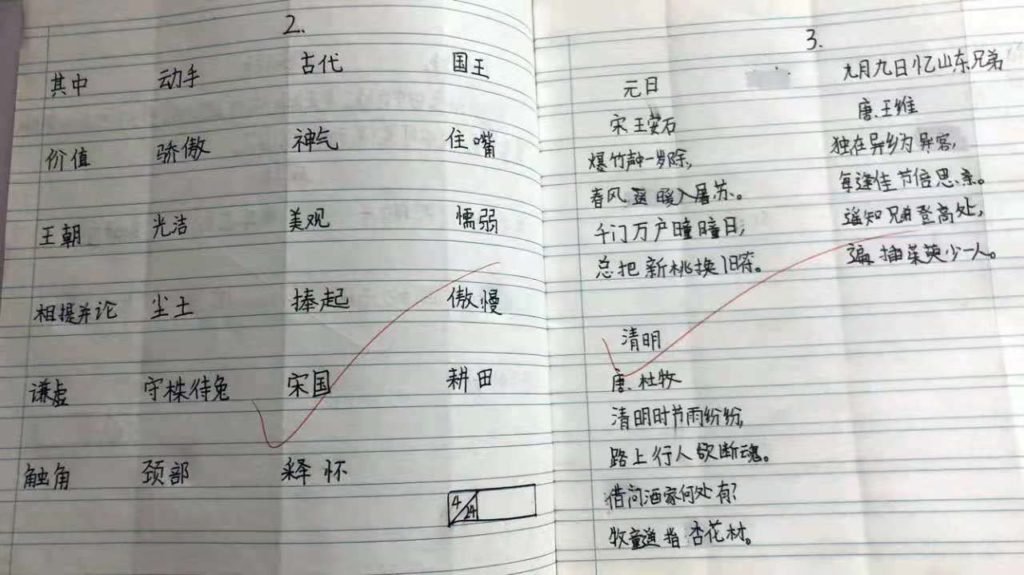
I wonder if the scheme will have a new name, to avoid confusion e.g. between old HSK 2 and new HSK band 2.
At GoEast we are already referring to the new HSK levels as B1 to B9 (instead of HSK1 to HSK9). But at the same time, if there is any confusion between HSK6 and the new HSK6, we think those confusions are temporary as the new HSK will soon become the new standard, just as when HSK was revamped in 2010.
Do high-level bands have grammar?
Yes, the advanced bands have in total 572 key grammar points, an additional 142 from Band 6.
How do I learn cultural things?
These cultural lessons will (should) be integrated into learning materials and courses. If you learn at GoEast, you already know this. Not just are the videos scripted around cultural lessons, and does the teacher often mention cultural topics in the live lessons to give use to new vocabulary. Each chapter also comes with a dedicated ‘cultural article’ at the end.
Are the new words literature or spoken Chinese?
Both. The new words cover a lot of new Chinese words that you will use in modern China.
History of HSK
The first revamp of HSK
From 1992, HSK had 11 levels. The levels were then simplified in 2010 and some contents removed, such as scientific terminology, sayings, and outdated words such as phonebooths. A total of 4189 words were purged, and 349 added.
The second revamp HSK levels (2010-2020)
Now, from 2010 t0 July 1st, 2021, HSK1 to HSK6 which ranges from Beginner (1&2) to Elementary (3) to Intermediate (4) to Advanced (5&6). In total there are around 5000 words to know.
At GoEast we commonly use the HSK system for our classes — because even if you just want to get conversational and don’t care about testing your Mandarin, the HSK structure works extremely well. It’s friendly to beginning students, and many characters you learn return in later levels as compound words. In HSK1 you may learn 谢谢Xièxiè (Thank you),in HSK3 觉得Juédé (Think), in HSK4 感谢Gǎnxiè (Thank) and 感觉(Gǎnjué). It’s also extremely popular, so there are lots of resources available — such as vocab lists specific per HSK level. Search ‘HSK3 vocab list’ on YouTube and you’ll find several people reciting.
Non-HSK Chinese language courses
HSK is how your Chinese language skills are officially graded, and as such, they’re often seen as the only way to learn Chinese. Which is a pity, because every Mandarin student’s goals are different. We think HSK1 to 4 are perfect to get conversational. After that, for some Chinese learners, HSK5 & 6 are perfect, for others, Spoken Chinese or Business Chinese is more suitable. This is because HSK5 and 6 are very much literature-based. HSK5 and 6 are not relevant in their entirety if you just want to make casual with Chinese people, or want to work in China. We expect the same literatury-focus from HSK7, 8, and 9.
